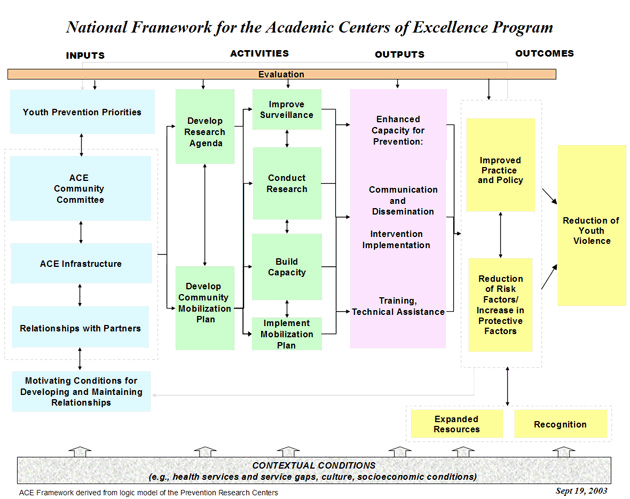ACE Program Evaluation
The 2005-2010 National Academic Centers of Excellence(ACE) in Youth Violence Prevention
The National Academic Centers of Excellence (ACEs) in Youth Violence Prevention use a unique multidisciplinary approach to violence prevention. The ACE Centers research youth violence prevention approaches, collect and analyze surveillance data, and foster relationships with local community partners to help develop, implement, and evaluate promising prevention efforts. This collaboration between research universities and local communities and community-based organizations results in empowered communities that are mobilized to address the problem of youth violence. In 2005, eight universities were funded: Columbia University, Harvard University, Johns Hopkins University, University of California at Berkeley, University of California at Riverside, University of Hawaii, University of Chicago, and Virginia Commonwealth University. Two additional universities were funded beginning in 2006 as Urban Partnership Academic Centers for Excellence (UPACEs): The Children’s Hospital of Philadelphia and Meharry Medical College. The purpose of the UPACEs is to serve high-risk, urban communities with youth homicide rates more than two times the national average. The ACEs and UPACEs together constitute the Division of Violence Prevention’s (DVP) ACE Program.
About the ACE Program Evaluation
In order to evaluate the work of the ACE Program, a program evaluation was conducted by CDC during the final year of ACE funding. The ACE Information System (IS) was used to collect data, including information about how inputs are being used to shape the ACE Program, which activities are undertaken by the ACEs, the nature of the activities, and the specific outcomes the program is accomplishing. The National ACE Program logic model has served as a planning mechanism for the ACE Program Evaluation. The Funding Opportunity Announcement for the 2005-2010 ACEs included a list and description of performance indicators (listed below) to track and measure the progress of the ACE Program and each ACE in meeting the goals and objectives in the logic model. The performance indicators provided a set of key determinants for the evaluation of the ACE Program’s impact on improved practice and policy, as well as the ACEs’ impact on reduction of risk factors or increase in protective factors. These indicators were subsequently integrated into the creation of the IS, which functions as a project management and reporting system:
- Evidence of ACE Community Committee participation in the determination of ACE violence prevention priorities;
- Evidence of establishment of partnerships and maintenance of partnerships;
- Establishment of a Community Mobilization Plan;
- Evidence that the ACE Center is mobilizing the community to implement evidence-based strategies or promising programs;
- Evidence of complete Center agenda/plans;
- Establishment of a Research Agenda;
- Establishment of projects and outcome/impact of effectiveness in the community;
- Evidence of community improvements in the ability to monitor and describe youth violence;
- Evidence of a communication and dissemination plan;
- Extent to which Center activities and evidence-based activities (EBA) have been translated into the outcomes listed; and
- Evidence of new grants, contracts or other resources awarded to ACE Center or its partners.
Conceptual Framework and Logic Model
The conceptual framework for the ACE Program was developed to describe the future orientation of the program, its activities, and the outcomes it expects to achieve. The national framework or logic model was created through a participatory process involving a diverse set of national, state, and local stakeholders and ACE grantees, and draws heavily from the Centers for Disease Control (CDC) Prevention Research Centers (PRC) model. The elements of the framework and its linkages are consistent with the Congressional language authorizing the establishment of the ACE program and CDC’s National Center for Injury Prevention and Control (NCIPC) research policies.
This model served as a planning mechanism for each center in guiding activities during the 5-year grant period. The framework identifies the inputs, activities, outputs, and outcomes common to all ACEs and shows the expected relationships among these components. The diagram of the logic model below summarizes how the program is presumed to work. Although the boxes of the framework are shown in a linear fashion, the relationships among them are expected to be complex, interactive, and recursive over time.
The national framework does not imply that one size fits all. To reflect uniqueness, each ACE created their own logic model by tailoring the national framework to the Center’s specific activities and goals. The national framework does not show the emphasis an individual ACE may place on one type of activity over another. The time required to achieve different outputs may vary among ACEs and is dependent on many factors, such as the type of research conducted and other activities undertaken, the amount of resources devoted to activities such as dissemination, and contextual factors. Thus, the framework does not specify the time it may take to achieve outputs or outcomes.
See below for a graphic of the ACE Logic Model. To read additional information about the inputs, activities, outputs, and outcomes please click on the logic model.

- Page last reviewed: January 14, 2014
- Page last updated: January 14, 2014
- Content Source:


 ShareCompartir
ShareCompartir
